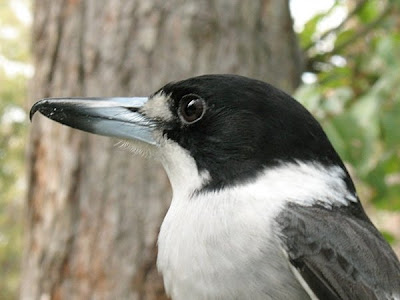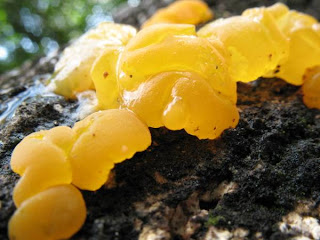
Monday, 7 May 2007
Gymnopilus Emerging
Found a clump of Gymnopilus junonius just breaking through the soil. In the location they're growing I should have little difficulty in observing their life cycle. They seem to be quite a common species around the area although I've only observed them growing at the base of Spotted Gum~ Eucalyptus maculata.


Butcherbird Visits
The Grey Butcherbird~ Cracticus torquatus is a pretty cool and rather fearless little bird that is prepared to stand its ground and defend its territory against larger birds. Butcherbirds feed mainly on insects, but their diet may also include small mammals, reptiles and even other birds. I once observed a Butcherbird spend ten minutes or longer in an eventually unsuccessful pursuit of a Red-Whiskered Bulbul and I'm sure had it managed its quest, then things would have been grim indeed for the Bulbul (which would be the same size or even slightly larger)


This little lad or ladette hangs around here quite a bit chasing dragonflies and other insects. Took me several days to gain its confidence and get up close.


This little lad or ladette hangs around here quite a bit chasing dragonflies and other insects. Took me several days to gain its confidence and get up close.
Sunday, 6 May 2007
Little Jelly Fungus
I have been doing some research into fungi on the Australian National Botanic Gardens' website and others, trying to learn about the various types of fungus and the species I'm likely to come across in my forays around the region. I was delighted the other day to come across this pretty, little example of what I think is Tremella mensenterica (Thanks Elfram for the ID). We had just received 26mm of rain to follow on from 42mm we got the week previous. There were quite a few of these little growths occurring on the trunk of a fallen Banksia serrata and they were nice and plump in the prime of their growth. Don't let the benign appearance of this fungus mislead you, although it is found growing on dead wood, it actually exists by parasitising other fungi species . It appears it is a very delicate fungus, as a couple of examples burst open very easily at my touch and oozed a gooey orange viscous liquid. I went back to the same place a few days later and all that remained were some orange stains on the trunk that gave no indication of their origin.


A Little Brown Spider
Came across a little spider the other day which I'm also yet to find a species. I think it may well be one of the Slender Sac Spiders of the genus Cheiracanthium of which there are about15 Australian species belonging to the Miturgidae family, or long-legged sac spiders. Cheiracanthium was formerly placed in the family Clubionidae.
He was nothing special, just a drab little brown critter sitting on a piece of bark. Not very big, the body would be around 9mm long.



-----------------------------------------------------------------------------------------------
Still had no joy in getting an ID on the little white moth from my last post, I'm going to see if I can find someone that I can email my images to. I really would like to find out what it is.
I have managed to get the names for a few of the fungi which I've come across in recent weeks, so I must thank those members of a particular forum that have helped me make identifications. Now I must get organised and update my files and captions for images.
He was nothing special, just a drab little brown critter sitting on a piece of bark. Not very big, the body would be around 9mm long.



-----------------------------------------------------------------------------------------------
Still had no joy in getting an ID on the little white moth from my last post, I'm going to see if I can find someone that I can email my images to. I really would like to find out what it is.
I have managed to get the names for a few of the fungi which I've come across in recent weeks, so I must thank those members of a particular forum that have helped me make identifications. Now I must get organised and update my files and captions for images.
Subscribe to:
Comments (Atom)







